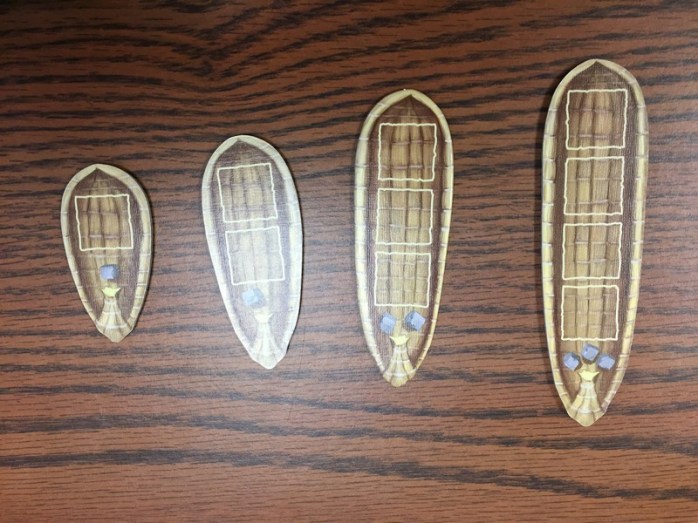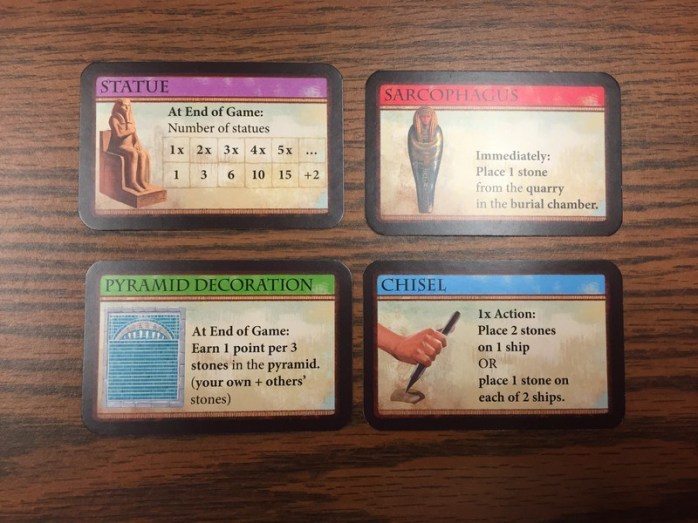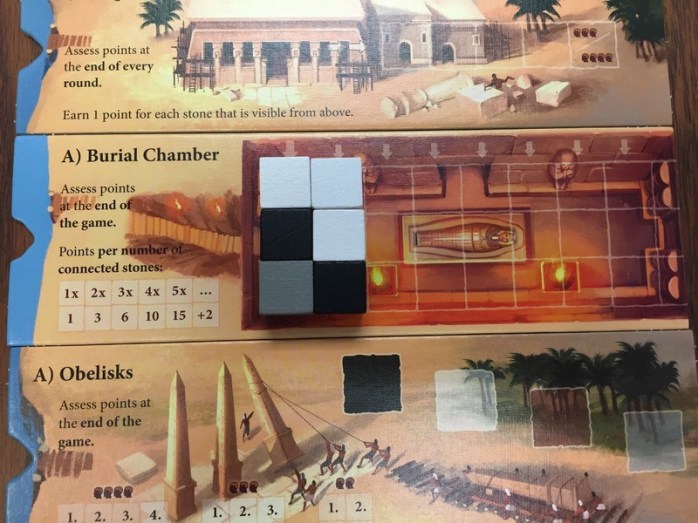Dude! Take Your Turn!
A Gaming Life
Review – Imhotep
I really seem to have an affinity for Ancient Egypt. I’ve played around with burying things and trying to earn the regard of the Pharaoh. But now I want to become an architect! It’s always been my dream, since I couldn’t become a lumberjack.

What better place to be an architect than Ancient Egypt?
In Imhotep, players are architects vying to build the most prestigious buildings and monuments in that desert area. They do this by getting stones, loading them on ships, and then shipping them to one of the five different sites where they can offload them.
Let’s see how this works.
Imhotep (published in 2016 by Kosmos, designed by Phil Walker-Harding with art by Miguel Coimbra and Michaela Kienle) is a game for 2-4 players where you are shipping stones and building stuff with them.
Each player gets a sled in their colour (very earthy colours of brown, white, black, and grey) that can hold up to five stones.

The game goes over 6 rounds, and each round a ship card is revealed from a stack that uses a group of cards based on the number of players. These are the available ships for this round.

At the start of the game, the first player gets two stones on their sled, the second gets three stones, third gets four, and fourth gets five.
During your turn, you can take one of four actions:
1) Take up to three stones from your supply to your sled
2) Place a stone on one of the available ships for that round. You can place the stone in any slot on the ship. It doesn’t have to be the first available space

3) Send one of the ships to a site and offload stones in the order from front to back of the ship. You can only do this if there are at least as many stones on the ship as shown on the front of the ship (the 4-stone ship shown above can only ship if there are three stones)
4) Play one of the blue cards that you may have taken from the Market site.
So where are you going to send these ships and offload stones?
That’s where the sites come in.

There are five sites where you can dock the ships. Each site board is double-sided, but the “A” side is the one you should probably start with and is what I’ll be talking about.
At the Market, you will be able to take one of the available cards in the order that your stones are offloaded from the ship (front to back).

At the Pyramid, stones are placed in order in the available squares and each player earns those points immediately. The columns are filled left to right, so in the picture above, the first stone offloaded would get two points, the second would get one point and the third would get three points.
At the Temple, stones are placed left to right to fill the squares, but when those are filled you go back to the beginning and put new stones on top. At the end of each round, the stones visible from above are scored.
At the Burial Chamber, columns are filled left to right. At the end of the game, each player earns points based on the number of connected stones of their colour

At the Obelisk, you just keep track of the number of stones placed here. At the end of the game, the player with the highest number of stones gets 1st place points, second-highest gets 2nd, etc.
The thing about the shipping action is that you don’t have to even have a stone on a ship to send it on its way. Thus, there is a bit of “take that” in that you can send a ship that one player is clearly setting up to get a bunch of points for the Pyramid to the Burial Chamber instead where it may not actually connect their stones very well. Or to the Obelisk where they already have first place and probably will, so those stones will be pretty much worthless.
Once all four ships have sailed (thus one site each round will not get any new stones), Temple scoring is done, the remaining cards in the market are cleared, and a new ship card is revealed. The next round begins with the next player.
After six rounds, total all of the end-game points and see who wins!
Is Imhotep a Master Architect or is he a Journeyman who builds lopsided monuments?
I love Imhotep to pieces (just an expression; no buildings were harmed in that statement). It’s a wonderfully quick game, easy to teach, perfect to play over a lunch period. Even my non-gamer co-workers haven’t had any trouble picking it up.
First, lets talk about components.
The stones are nice and chunky; the pieces are sturdy cardboard and the artwork is phenomenal. Wonderful earthy tones with art that really brings you to the desert sands. The score track looks like a path to drag your stone along.

The gameplay is really simple but the tactics you use are thinky and you have to decide just how much you want to prepare your own stuff versus making sure other players can’t score high. You can’t do both, and you are sacrificing a turn when you “hate-ship” somebody else’s stones where they don’t want them to go.
When you’re placing a stone on a ship, which slot should you put it in? Maybe the second one so you can make sure it connects to your other Burial Chamber stones correctly? But then an opponent ships you to the Pyramid instead and you get 1 point instead of the 10 that having four connected stones in the Burial Chamber would get you.
There is no strategy in this game, as you are always reacting to what other players are doing. It’s a very tactical game. That’s not a bad thing, just an observation. I love tactical games.
The ease of play is the main attraction. It’s easy and attractive enough to bring in that non-gamer who is wondering what you are spending your time on all day, the one who you want to show that games are not just Monopoly now.
One of my co-workers was intrigued by the cover and wanted to play. Never played a “gamer’s game” in her life. After one round, she really understood the game and while she didn’t win (another newcomer did, actually), she greatly enjoyed herself.
You wouldn’t think that because there is the “take that” element of shipping, but it didn’t bother her at all. Some people don’t like that aspect of games, so if you don’t like any “take that” then you will not like this game. It can be quite cutthroat.
Even more so at two players, I would think. Imhotep plays 2-4 players, but personally I wouldn’t bother with two. Some people like it, I’m sure, but I think it would be too cutthroat for my enjoyment.
I have played it at three and four players, and it works really well at both. There isn’t much downtime. Yes, there can be a little analysis paralysis as you calculate possible points, but since your choices are somewhat limited, it’s not that bad.
I highly recommend Imhotep as a good way to bring new gamers into the hobby, or as an excellent beginning/end game for a game day. It takes 45 minutes to an hour and it’s just really satisfying.
Check it out if you can!
I’m anxiously waiting for the expansion to come out over in North America and in English.
(This review was written after 5 plays)
This is one I’ve heard a lot of good things about – even more now! I like that you have to kind of cooperate with your opponents. Also the idea of sending someone’s goodies to another site seems to tickle me in the right place.
LikeLiked by 1 person
LOL I don’t know if “cooperate” is the right word. This game can be pretty mean. 🙂
LikeLiked by 1 person
Pingback: Board Game Bloggers to Sink Your Teeth Into – Roll to Review
Pingback: New to Me – May 2017 – Dude! Take Your Turn!